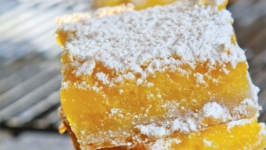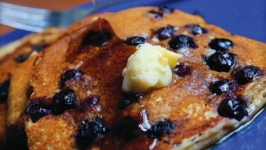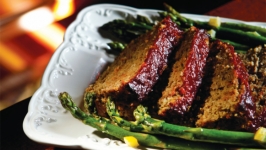Ingredients
- 1 cup whole milk, divided
- 1½ cups water
- ½ cup yellow cornmeal
- 3 tablespoons unsalted butter
- ½ cup sorghum or mild molasses
- 1 teaspoon salt
- 1 teaspoon sugar
- 1 tablespoon active dry yeast
- 6½ to 7 cups all-purpose flour
Instructions
In a medium pan, heat ¾ cup of the milk with the water just until lukewarm. Add the cornmeal and cook over low heat, stirring constantly, until small bubbles appear around the edge. Immediately remove from the heat. Stir in the butter, sorghum and salt; transfer to a large bowl and let cool.
While the cornmeal mixture is cooling, in a small saucepan heat the remaining ¼ cup of milk with the sugar until lukewarm. Remove from the heat. Sprinkle the yeast over the milk and let stand until foamy, about 10 minutes. Stir the yeast mixture into the cornmeal. Stir in 6½ cups of the flour, until a stiff dough forms.
Sprinkle a few tablespoons of the remaining ½ cup of flour onto a work surface. Turn the dough out onto the floured surface and knead until smooth and elastic, adding the remainder of the ½ cup of flour as needed, a tablespoon at a time. The dough will be tacky to the touch, (like Scotch tape) while you are kneading it, and when it is smooth and no longer tacky it is time to stop kneading.
Form the dough into a ball and transfer it to a lightly buttered bowl. Cover the bowl with plastic wrap and let rise in a warm, draft-free spot until doubled in bulk, about 1 hour.
Lightly butter two 8½- by 4½-inch loaf pans (or use two 8 by 8 by 2 inch square pans.) Punch down the dough and divide it in half. Form each half into a loaf and place in the prepared pans. Dust the tops lightly with flour, cover with a clean, dry kitchen towel and let rise in a warm, draft-free spot until nearly doubled in bulk, about 1 hour.
Preheat the oven to 350°. Bake the loaves for 50 minutes, or until the tops are brown; carefully turn out onto a rack.The loaves should sound hollow when tapped on the bottom; if they don’t, return them to the pans and bake a few minutes more. Cool completely before slicing.
The bread can be stored at room temperature, wrapped in foil or in a plastic bag, for up to 4 days.
If you’ve never tried your hand at yeast bread, this is a great one to start with. It traditionally uses molasses, obtained in New England through the Caribbean sugar trade, but I use local sorghum. Served warm, with fresh butter and sorghum, it absolutely cannot be beat to serve with hearty soups. Bonus: It makes excellent toast and sandwich bread, too.
A tip for you novice bread bakers: For years, I was anxious about dough sticking to my fingers and I always ended up adding way too much flour to prevent this, resulting in an edible but not great loaf of bread. A few years ago, while reading a bread recipe I came across the description of dough as being “tacky.” Once I finally got it in my head that there would be a little stickiness while kneading, I quit adding so much flour in the kneading process, and my breads and pizza crusts always turn out beautifully now.
Another tip if you think you’ll get into baking anything that requires rolling out or kneading: I highly recommend a large silicon mat, usually called a Roul-Pat (available at local kitchen shops). I used to use a pastry cloth and always had to add a lot of extra flour to keep doughs from sticking to it. With the silicon mat, I use so much less flour now and my pastries and breads are much more consistent.








